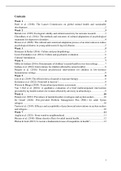Summary
Summary Cross-Cultural & Global Mental Health Master Psychology
- Course
- Institution
This is a summary of all the articles for the master course Cross-Cultural & Global Mental Health. The summary will be updated weekly until finished.
[Show more]












